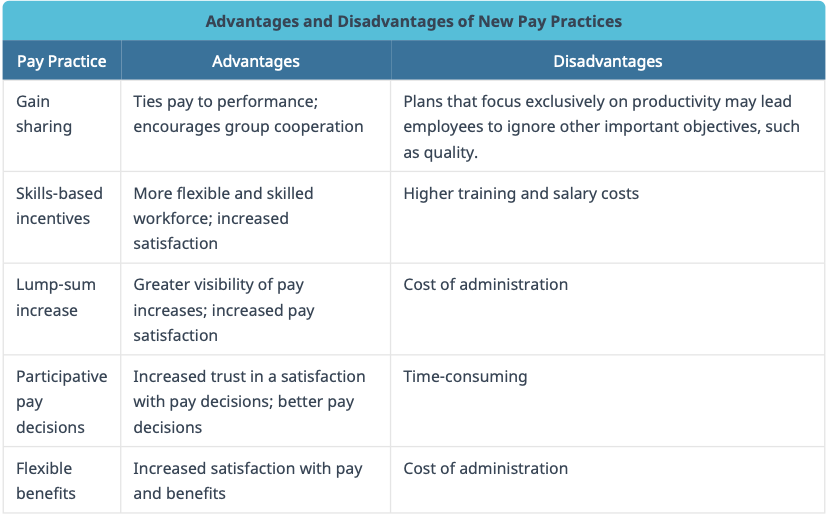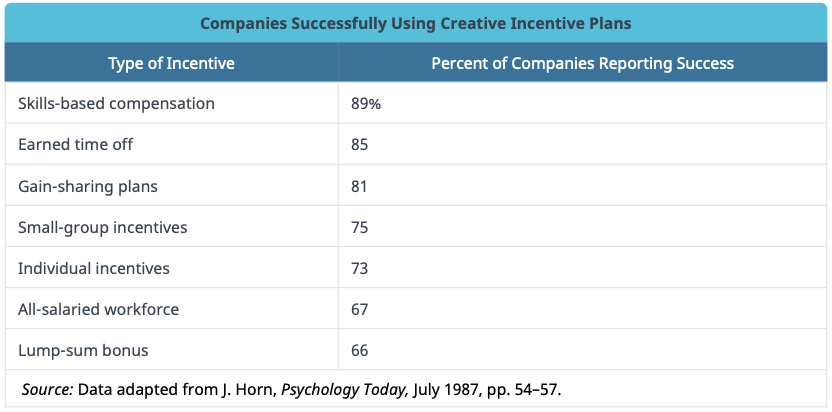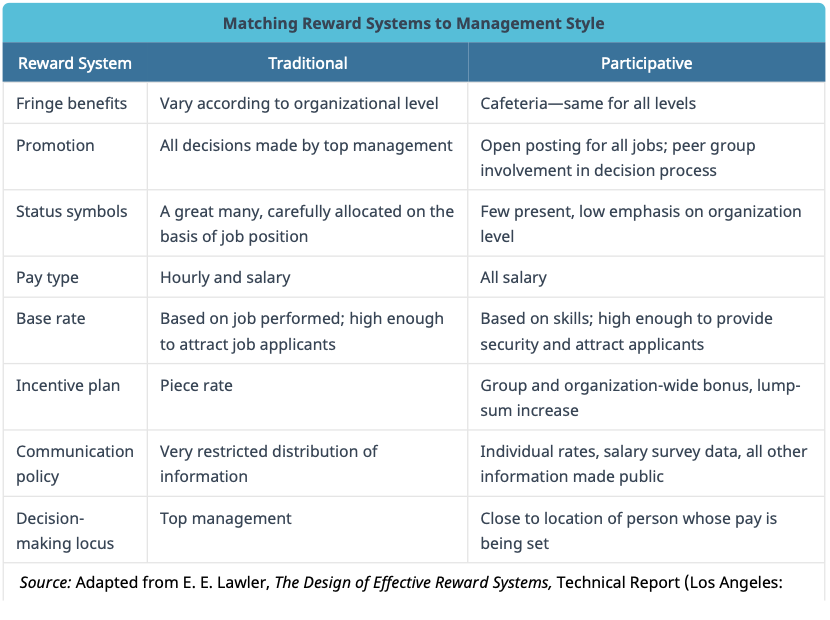14.8.5: Individual and Group Incentive Plans
- Last updated
- Save as PDF
- Page ID
- 60197
5. How do managers and organizations use incentives and rewards effectively to secure the best possible performance from employees?
We now turn to an examination of various employee incentive programs used by organizations. First, we consider the relative merits of individuals versus group incentive programs. Next, we focus on several relatively new approaches to motivation and compensation. Finally, we suggest several guidelines for effective incentive systems.
Individual versus Group Incentives
Companies usually have choices among various compensation plans and must make decisions about which is most effective for its situation. Incentive systems in organizations are usually divided into two categories on the basis of whether the unit of analysis—and the recipient of the reward—is the individual or a group. Among individual incentive plans, several approaches can be identified, including merit-based compensation (commonly known as merit compensation), piece-rate incentive programs (where people are paid according to the quantity of output), bonus systems of various sorts, and commissions. In each case, rewards are tied fairly directly to the performance level of the individual.
Although individual incentive systems often lead to improved performance, some reservations have been noted. In particular, these programs may at times lead to employees competing with one another, with undesirable results. For instance, department store salespeople on commission may fight over customers, thereby chasing the customers away. After all, customers don’t care who they deal with, only that the service is good. Second, these plans typically are resisted by unions, which prefer compensation to be based on seniority or job classification. Third, where quality control systems are lax, individual incentives such as piece rates may lead employees to maximize units of output while sacrificing quality. And, finally, in order for these programs to be successful, an atmosphere of trust and cooperation is necessary.
In order to overcome some of these shortcomings, many companies have turned to group or organizational incentive plans. Group incentive programs base at least some of an employee’s rewards on group or organization performance. Hence, employees are encouraged to cooperate with one another and with the corporation so that all employees can benefit. Programs such as profit-sharing or gain-sharing plans (discussed below) are designed to tie the employees’ future rewards and prosperity to that of the company and reduce the age-old antagonism between the two. The results are often dramatic.
Creative Pay Practices
Recently, we have seen several innovations in the way corporations approach reward systems. These efforts are designed to facilitate the integration of employee and company interests in a way that maximizes both productivity and quality of working life. Five such creative pay practices should be noted: (1) gain-sharing plans, (2) skills-based incentives, (3) lump-sum pay increases, (4) participative pay decisions, and (5) flexible benefits programs. These approaches, along with their major advantages and drawbacks, are summarized in Table 8.7.

Gain-Sharing Plans. Giving executives and senior managers bonuses to reflect their contributions to organizational effectiveness is commonplace. In fact, in some companies executive bonuses are often larger than salaries. Recently, companies have increasingly applied this same principle to all employees in the form of gain-sharing (profit-sharing) plans. Here, employees are given a chance to share in corporate productivity gains through increased earnings. The greater the productivity gains, the greater the earnings. Several variations on this theme can be found, including the Scanlon Plan, IMPROSHARE, the Ruker Plan, and the Lincoln Electric Plan. Regardless of the title, the basic plan is similar.
For example, under the Scanlon Plan (probably the oldest such program), three operating guidelines are used: (1) each department or division is treated as a business unit for purposes of performance measurement, (2) specific cost measures associated with the production process are identified and agreed to by all parties, and (3) bonuses are paid to all employees according to a predetermined formula tying the amount of the bonus to the actual cost savings realized during the time period. Under such a plan, it is clearly in the employees’ best interest to contribute to cost savings, thereby increasing their own incomes.
expanding around the GLobe
Providing Feedback in Different Countries
Global workplaces are increasing within the world businesses, and it has become a trend to have managers from one country, most likely the country in which the headquarters arise, manage employees abroad. An important consideration when managing globally is how cultural differences can have a profound effect on performance evaluations, negotiations, and criticisms.
For example, oftentimes in the United States, a method of critical feedback in the “hamburger method” (Step 1: Identify tasks. As a group, identify technical steps that would be involved in implementing. Step 2: Identify options for tasks. Split the team into several small groups. Step 3: Combine results.) is acceptable, while other countries give their feedback with just the meal alone. This strategy in the Netherlands and Germany can be off-putting to other cultures, and when you read into another culture’s technique with your own lens of reference, it can feel wrong.
Managing globally means that you need to do your research on which approach for feedback is best received for the employee’s cultural differences. For example, being direct is key when communicating with a Dutch person. In contrast, in England or the United States, criticism is not delivered directly, but with positive pieces wrapped around the negative. In Asian countries, feedback is often avoided or the message is blurred in order to “save face.” With all of these complications and considerations, it is ever more important to acutely understand the culture, the cultural understandings of employees who are direct reports, and also the lens through which feedback is being viewed as well.
Questions:
- How can a new manager that is working with international employees ensure she is providing reviews in an appropriate manner?
- What methods can a manager employ in her preparation for the review to be successful when providing feedback to employees of different cultures?
Sources: C. Solbach. “Feedback through cultural looking glass.” Krauthammer, September 16, 2015, www.krauthammer.com/en/publi...2/07/feedback- through-cultural-looking-glass; M. Abadi. “The exact same sentence from your boss can mean 'yes,' 'no,' or 'maybe' depending on the country where you work.” Business Insider, December 7, 2017, https://www.businessinsider.com/dire...ulture-2017-12; J. Windust. “An International Approach to 360-Degree Feedback.” Cognology, July 26, 2016, https://www.cognology.com.au/interna...gree-feedback/; “Giving Employee Feedback To A Culturally Diverse Workforce.” Impraise Blog, accessed January 26, 2019, blog.impraise.com/360-feedba...ences-between- branchescountries-in-feedback-behavior-performance-review.
Skills-Based Incentives. Typical compensation programs are tied to job evaluations. In these, jobs are analyzed to assess their characteristics, and then salary levels are assigned to each job on the basis of factors such as job difficulty and labor market scarcity. In other words, pay levels are set on the basis of the job, not the individual. This approach fails to encourage employees to improve their skills on the job, because there is no reward for the improvement. This thinking also keeps all employees in their places and minimizes the possibility of inter-job transfers.
Under the skills-based incentive program, employees are paid according to their skills level (that is, the number of jobs they can perform), regardless of the actual tasks they are allowed to perform. This approach has proved successful in organizations such as Procter & Gamble and General Foods. Employees are encouraged to learn additional skills and are appropriately rewarded. The organization is provided with a more highly trained and more flexible workforce. However, training and compensation costs are necessarily increased, so the program is appropriate only in some situations. The technique is most often seen as part of a larger quality-of-working-life program, where it is associated with job redesign efforts.
Lump-Sum Pay Increases. Another technique that has received some attention is to allow employees to decide how (that is, in what amounts) they wish to receive their pay raises for the coming year. Under the traditional program, pay raises are paid in equal amounts in each paycheck over the year. Under the alternate plan, employees can elect to receive equal amounts during the year, or they can choose to take the entire raise in one lump-sum pay increase. This plan allows employees greater discretion over their own financial matters. If an employee wants to use the entire pay raise for a vacation, it can be paid in a lump sum in June. Then, if the employee quits before the end of the year, the unearned part of the pay raise is subtracted from the final paycheck. This plan increases the visibility of the reward to the employee. The employee receives, for example, a $600 pay raise (a rather sizable amount) instead of twelve $50 monthly pay raises. As with the flexible rewards system discussed below, however, the administration costs of the lump-sum plan are greater than those of the traditional method.
Participative Pay Decisions. In addition, of concern to many managers is the extent to which employees should be involved in decisions over pay raises. This is the issue of participative pay decisions. Recently, several organizations have been experimenting with involving employees in pay raise decisions, and the results seem to be quite positive. By allowing employees to participate either in the design of the reward system or in actual pay raise decisions (perhaps through a committee), it is argued that decisions of higher quality are made on the basis of greater information. Also, employees then have greater reason to place confidence in the fairness of the decisions. On the negative side, this approach requires considerably more time for both the manager and the participating subordinates. Costs must be weighed against benefits to determine which approach is most suitable for the particular organization and its goals.
Flexible Benefits Systems. A typical fringe benefit package provides the same benefits—and the same number of benefits—to all employees. As a result, individual differences or preferences are largely ignored. Studies by Lawler indicate variations in benefit preferences.18 For instance, young unmarried men prefer more vacation time, whereas young married men prefer to give up vacation time for higher pay. Older employees want more retirement benefits, whereas younger employees prefer greater income. Through a flexible benefits program (also called a “cafeteria benefits program”), employees are allowed some discretion in the determination of their own packages and can make trade-offs, within certain limits. Organizations such as PepsiCo, TRW, and the Educational Testing Service already use such programs. Although certain problems of administration exist with the programs, efforts in this direction can lead to increased need satisfaction among employees.
We have seen a number of different creative solutions to the compensation dilemma. Which approaches are most effective in motivating employees? This is obviously a difficult question to answer. However, one way to get relevant information on this question is to see what corporations actually use. One such study asked major employers which of a variety of approaches had been used with a high success level. The results are shown in Table 8.8. As can be seen, skills-based compensation, earned time off, and gain sharing all received high marks from personnel executives, although other programs are also widely supported. It would appear from these results that many approaches can be useful; the choice of which one to use would depend upon the circumstances and goals of a particular organization.
Guidelines for Effective Incentive Programs
Whatever incentive plan is selected, care must be taken to ensure that the plan is appropriate for the particular organization and workforce. In fact, a simple test of the effectiveness of an incentive plan would be as follows:19
- Does the plan capture attention? Do employees discuss the plan and take pride in their early successes?
- Do employees understand the plan? Can employees explain how the plan works, and do they understand what they must do to earn the incentive?
- Does the plan improve communication? As a result of the plan, do employees understand more about corporate mission, goals, and objectives?
- Does the plan pay out when it should? Are incentives being paid for desired results, and are they withheld for undesirable results?
- Is the company performing better as a result of the plan? Are profits or market share up or down? Have any gains resulted in part from the incentive plan?

If a new (or existing) pay plan can meet these tests, it is probably fairly effective in motivating employee performance and should be retained by the organization. If not, perhaps some other approach should be tried. On the basis of such a test, several specific guidelines can be identified to increase the effectiveness of the programs. These include the following:20
- Any reward system or incentive plan should be as closely tied to actual job performance as possible. This point was discussed earlier in this chapter.
- If possible, incentive programs should allow for individual differences. They should recognize that different people want different outcomes from a job. Flexible benefits programs such as the ones discussed here make an effort to accomplish this.
- Incentive programs should reflect the type of work that is done and the structure of the organization. This simply means that the program should be tailored to the particular needs, goals, and structures of a given organization. Individual incentive programs, for example, would probably be less successful among unionized personnel than would group programs such as the Scanlon plan. This point has been clearly demonstrated in research by Lawler, which points out that organizations with traditional management and those with more participative management might approach reward systems quite differently in order to be effective.21 As shown in Table 8.9, both types of company can be effective as long as their reward systems are congruent with their overall approach to management.
- The incentive program should be consistent with the culture and constraints of the organization. Where trust levels are low, for example, it may take considerable effort to get any program to work. In an industry already characterized by high levels of efficiency, basing an incentive system on increasing efficiency even further may have little effect, because employees may see the task as nearly impossible.
- Finally, incentive programs should be carefully monitored over time to ensure that they are being fairly administered and that they accurately reflect current technological and organizational conditions. For instance, it may be appropriate to offer sales clerks in a department store an incentive to sell outdated merchandise because current fashion items sell themselves. Responsibility falls on managers not to select the incentive program that is in vogue or used “next door,” but rather to consider the unique situations and needs of their own organizations. Then, with this understanding, a program can be developed and implemented that will facilitate goal-oriented performance.


concept check
- What are the differences between individual and group incentives?
- What is the variety of reward incentives available to organizations?


